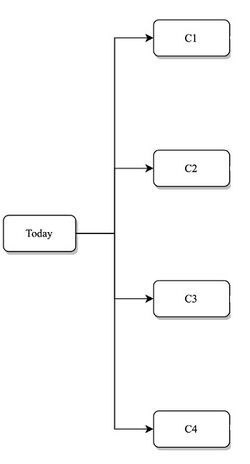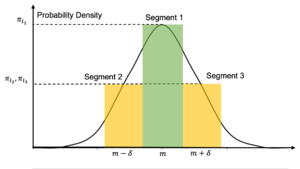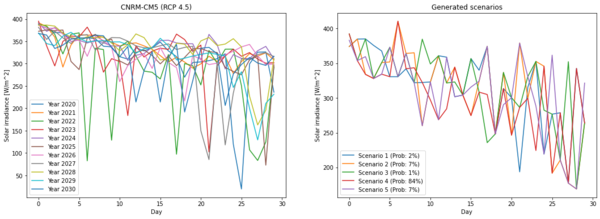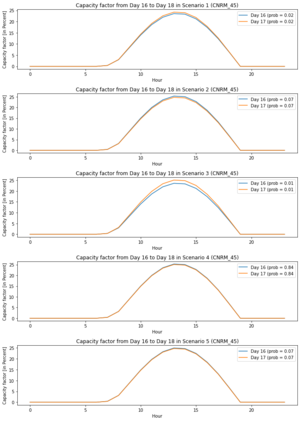The growth of renewable power generation has experienced a significant upsurge in recent years, primarily due to its environmentally sustainable nature and negligible fuel costs. Nevertheless, many renewable energy sources, including wind and photovoltaic (PV) solar power, are categorized as variable generation (VG). These sources exhibit a temporal fluctuation in their maximum generation capacity (variability), coupled with an inherent lack of precise predictability (uncertainty). The unpredictable nature of solar irradiance results in uncertain solar energy generation represented by a low-capacity factor, thereby posing challenges for grid operators in maintaining electrical supply reliability, balancing short-term electricity generation and demand, and planning for long-term capacity expansion of generation units.
Climate Models (CMs) can be utilized via probabilistic methodologies to integrate such uncertainties into future decision-making processes. Global Climate Models (GCMs) have been developed to predict future climatic conditions; however, their coarse outputs necessitate downscaling to achieve spatial and temporal resolutions appropriate to specific studies. Statistical and dynamical downscaling techniques can be employed to achieve the desired resolution for GCMs.[1] Portals such as Euro-cortex (globally) and Cal-Adapt (California, USA) provide access to downscaled climate models within the temporal framework of the Fifth Assessment Report[2](AR5) of the Intergovernmental Panel on Climate Change[3] (IPCC). CM datasets contain multiple scenarios for each climatic variable, such as solar irradiance.
Due to the inherent uncertainties of CMs, scenario-based methods, including scenario trees and Monte Carlo simulation[4] (MCS), can be used to generate a large set of scenarios (). Each scenario represents a potential realization of random variables in conjunction with their associated probabilities of occurrence ().
Scenario tree[edit | edit source]

In the first step, different scenario trees can be structured depending on the desired number of climate models. As none of the climate models have priority over the other, by considering the same probability of occurrence of all models, the probability of each branch is:
Monte-Carlo Simulation[edit | edit source]
Monte-Carlo simulation then can be used to generate number of scenarios based on the mean and standard deviation of values of each climate variable of each branch. The Monte Carlo simulation procedure is adopted from the paper titled "An efficient scenario-based stochastic programming framework for multi-objective optimal micro-grid operation" by Niknam et al..[5] The Monte Carlo simulation steps are as follows:
- The normal distribution of each time step is calculated based on the mean () and standard deviation () of each step's values in all years (e.g., ).
- The normal distribution functions are obtained for all time steps.
- Each function is divided into three segments (), each by a distance (). Depending on the desired level of preciseness, the number of segments can be increased.

- The cumulated probability of segments is normalised to unity based on the following equation in a way in which their summation becomes equal to 1 ():

- A random number is generated for each time step. The segment with a probability less or equal to the random number is selected as the value of that step, and the corresponding probability is the probability of that segment ().
- The probability of all sample data (SD) is normalised using equation:
By knowing the probability of each sample data obtained from step 6, the probability of each scenario is .

Depending on the desired accuracy of the model, a higher number of scenarios can be generated with a more arduous computation cost. As a result, scenario-reduction methods can be implemented to reduce the number of scenarios based on the required approximation accuracy.
PV Modeling[edit | edit source]
The obtained scenarios are used in PV models to estimate the power generation of units. The power output of a PV module can be calculated as follows:
Where is the power output of PV, is the maximum power output of PV in the standard test condition, is the solar irradiance at time t , is the solar irradiance in standard test condition (), is the number of PV panels, is the temperature coefficient (), is the temperature of PV in standard test condition (), and is the PV temperature and is calculated as follows:

Where is the ambient temperature and is the constant given by manufacturer (= 30). By considering a 100 PV module, the power output of PV can be intercepted as the capacity factor of PV at each time step (). The obtained capacity factor can be used in modelings and optimization problems as a parameter to transform the nominal capacity of PV units into power output.
The results can help grid operators prepare for increases in PV generation share and improve system reliability when integrating PV generation. Furthermore, the outputs can be used in future studies, such as optimal sizing of power system units, and aid decision-makers in the long-term planning of power systems.
References[edit | edit source]
- ↑ C. Hellström, D. Chen, C. Achberger, and J. Räisänen. "Comparison of climate change scenarios for Sweden based on statistical and dynamical downscaling of monthly precipitation". Climate Research, 19(1):45–55,11 2001. ISSN 0936-577X. doi: 10.3354/CR019045.
- ↑ Fifth Assessment Report (AR5)-Intergovernmental Panel on Climate Change (IPCC)
- ↑ Intergovernmental Panel on Climate Change
- ↑ A.M. Johansen, "Monte Carlo Methods", Editor(s): Penelope Peterson, Eva Baker, Barry McGaw, International Encyclopedia of Education (Third Edition), Elsevier, 2010, Pages 296-303, ISBN 9780080448947, https://doi.org/10.1016/B978-0-08-044894-7.01543-8. https://www.sciencedirect.com/science/article/pii/B9780080448947015438
- ↑ Taher Niknam, Rasoul Azizipanah-Abarghooee, and Mohammad Rasoul Narimani. "An efficient scenario-based stochastic programming framework for multi-objective optimal micro-grid operation". Applied Energy, 99:455–470, 11 2012. ISSN 0306-2619. doi: 10.1016/J.APENERGY.2012.04.017.










![{\displaystyle \Pi _{l_{i}}^{N}={\frac {\Pi _{l_{i}}}{\sum _{i}{\Pi _{l_{i}}}}}\quad i\in {[1,2,3]}}](https://wikimedia.org/api/rest_v1/media/math/render/svg/9ee667fb427454905a93415080fac61766b8ddf5)



![{\displaystyle P_{PV}(t)=P_{STC}\cdot n\cdot {\frac {E_{m}(t)}{E_{STC}}}\cdot [1+k\cdot (T_{m}(t)-T_{STC})]}](https://wikimedia.org/api/rest_v1/media/math/render/svg/c641688c811c0b94a2a3511cfe0c24a7053d8233)



![{\displaystyle [{\frac {W}{m^{2}}}]}](https://wikimedia.org/api/rest_v1/media/math/render/svg/b9985ef0bf052c07ebc1dbbf2392fc0d9525261d)

![{\displaystyle =1000[{\frac {W}{m^{2}}}]}](https://wikimedia.org/api/rest_v1/media/math/render/svg/cd9e5db84c94ac110bbf94e29ed0ac6488bb7b07)


![{\displaystyle =-0.0049[{\frac {1}{^{\circ }C}}]}](https://wikimedia.org/api/rest_v1/media/math/render/svg/ba85a2acb0b716719d5d1650011fbd5c300283c6)







![{\displaystyle [W_{nominal}]}](https://wikimedia.org/api/rest_v1/media/math/render/svg/ac071201753232a197e3ae56cf7ad778cc68e236)
